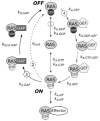New insights into RAS biology reinvigorate interest in mathematical modeling of RAS signaling
- PMID: 29518522
- PMCID: PMC6123307
- DOI: 10.1016/j.semcancer.2018.02.008
New insights into RAS biology reinvigorate interest in mathematical modeling of RAS signaling
Abstract
RAS is the most frequently mutated gene across human cancers, but developing inhibitors of mutant RAS has proven to be challenging. Given the difficulties of targeting RAS directly, drugs that impact the other components of pathways where mutant RAS operates may potentially be effective. However, the system-level features, including different localizations of RAS isoforms, competition between downstream effectors, and interlocking feedback and feed-forward loops, must be understood to fully grasp the opportunities and limitations of inhibiting specific targets. Mathematical modeling can help us discern the system-level impacts of these features in normal and cancer cells. New technologies enable the acquisition of experimental data that will facilitate development of realistic models of oncogenic RAS behavior. In light of the wealth of empirical data accumulated over decades of study and the advancement of experimental methods for gathering new data, modelers now have the opportunity to advance progress toward realization of targeted treatment for mutant RAS-driven cancers.
Keywords: ERK cascade; Mathematical modeling; Mechanistic modeling; RAS; Systems biology.
Copyright © 2018 Elsevier Ltd. All rights reserved.
Conflict of interest statement
The authors declare that they have no conflict of interest.
Figures



Similar articles
-
Inhibitors of the ERK mitogen-activated protein kinase cascade for targeting RAS mutant cancers.Enzymes. 2013;34 Pt. B:67-106. doi: 10.1016/B978-0-12-420146-0.00004-4. Epub 2013 Nov 7. Enzymes. 2013. PMID: 25034101 Review.
-
Therapeutic Approaches to RAS Mutation.Cancer J. 2016 May-Jun;22(3):165-74. doi: 10.1097/PPO.0000000000000187. Cancer J. 2016. PMID: 27341593 Free PMC article. Review.
-
Direct inhibition of RAS: Quest for the Holy Grail?Semin Cancer Biol. 2019 Feb;54:138-148. doi: 10.1016/j.semcancer.2017.12.005. Epub 2017 Dec 14. Semin Cancer Biol. 2019. PMID: 29248537 Free PMC article. Review.
-
Network analysis of oncogenic Ras activation in cancer.Science. 2007 Oct 19;318(5849):463-7. doi: 10.1126/science.1144642. Science. 2007. PMID: 17947584
-
Clinical Translation of Combined MAPK and Autophagy Inhibition in RAS Mutant Cancer.Int J Mol Sci. 2021 Nov 17;22(22):12402. doi: 10.3390/ijms222212402. Int J Mol Sci. 2021. PMID: 34830283 Free PMC article. Review.
Cited by
-
Dynamic regulation of RAS and RAS signaling.Biochem J. 2023 Jan 13;480(1):1-23. doi: 10.1042/BCJ20220234. Biochem J. 2023. PMID: 36607281 Free PMC article.
-
Adagrasib, a KRAS G12C inhibitor, reverses the multidrug resistance mediated by ABCB1 in vitro and in vivo.Cell Commun Signal. 2022 Sep 14;20(1):142. doi: 10.1186/s12964-022-00955-8. Cell Commun Signal. 2022. PMID: 36104708 Free PMC article.
-
Expression of oncogenic HRAS in human Rh28 and RMS-YM rhabdomyosarcoma cells leads to oncogene-induced senescence.Sci Rep. 2021 Aug 13;11(1):16505. doi: 10.1038/s41598-021-95355-2. Sci Rep. 2021. PMID: 34389744 Free PMC article.
-
Regulation of the Small GTPase Ras and Its Relevance to Human Disease.Methods Mol Biol. 2021;2262:19-43. doi: 10.1007/978-1-0716-1190-6_2. Methods Mol Biol. 2021. PMID: 33977469 Review.
-
Identification of microRNA-92a and the related combination biomarkers as promising substrates in predicting risk, recurrence and poor survival of colorectal cancer.J Cancer. 2019 Jun 2;10(14):3154-3171. doi: 10.7150/jca.30306. eCollection 2019. J Cancer. 2019. PMID: 31289586 Free PMC article.
References
-
- Barbacid M. Ras Genes. Annu Rev Biochem. 1987;56:779–827. - PubMed
-
- Stephen AG, Esposito D, Bagni RG, McCormick F. Dragging Ras back in the ring. Cancer Cell. 2014;25:272–281. - PubMed
-
- Ho AL, Chau NG, Wong DJL, Cabanillas ME, Bauman JR, Bible KC, Brose MS, Calvo E, Boni V, Burrows F, Melvin CL, Scholz CR, Gualberto A. An open-label, phase II study of tipifarnib for the treatment of HRAS mutant solid tumors, including squamous cell carcinomas of the head and neck. J Clin Oncol. 2017;35
Publication types
MeSH terms
Substances
Grants and funding
LinkOut - more resources
Full Text Sources
Other Literature Sources
Miscellaneous

